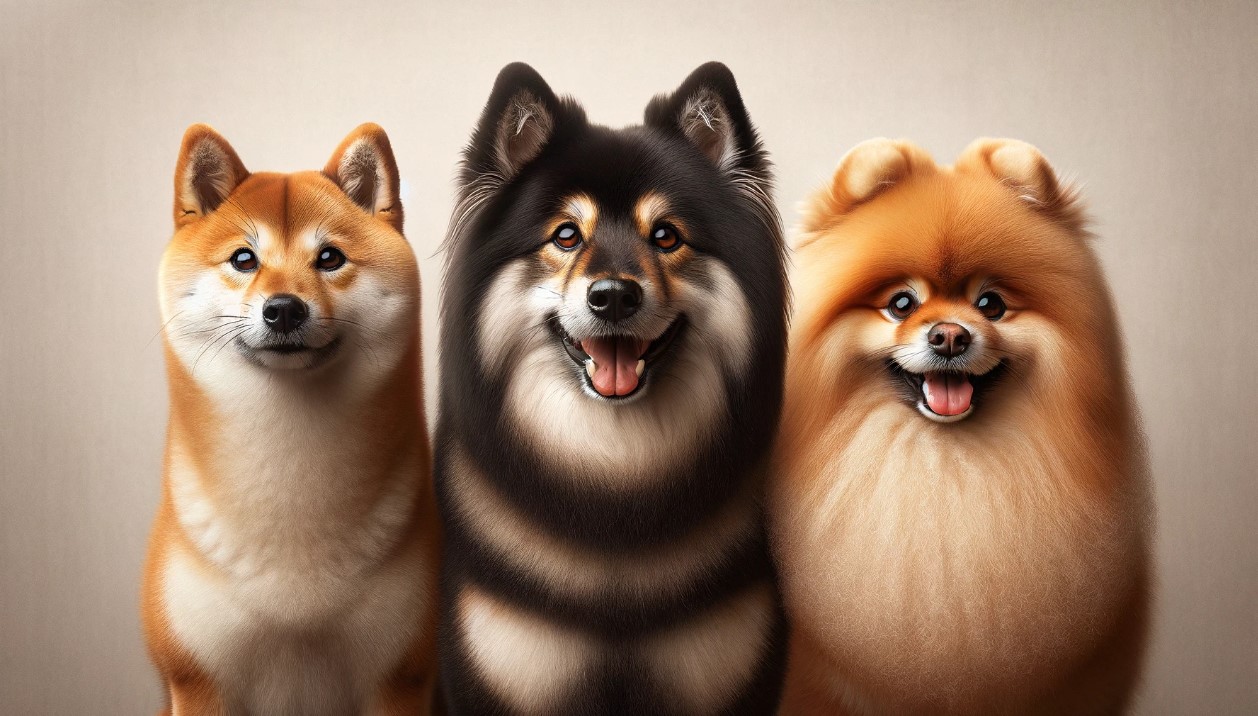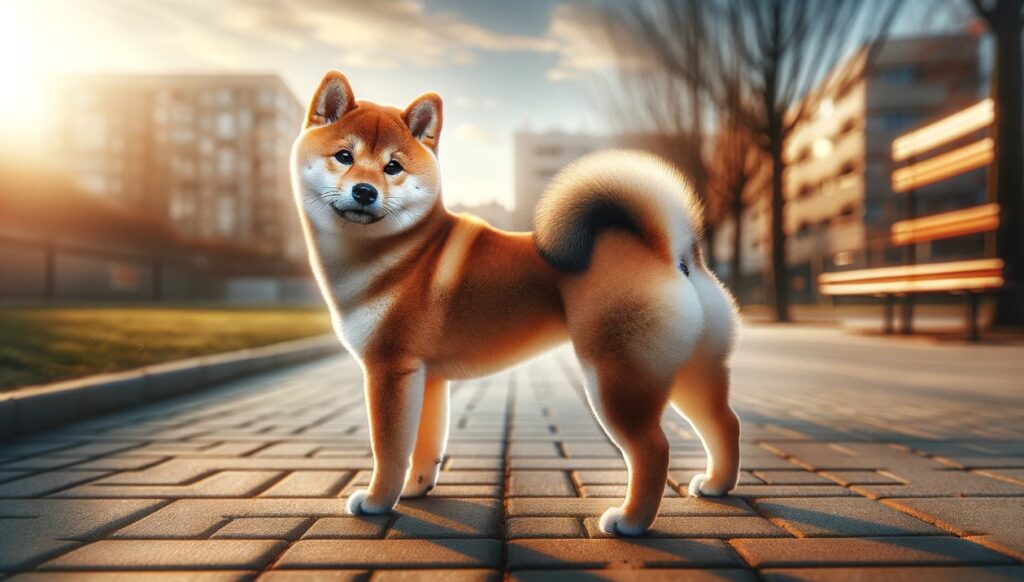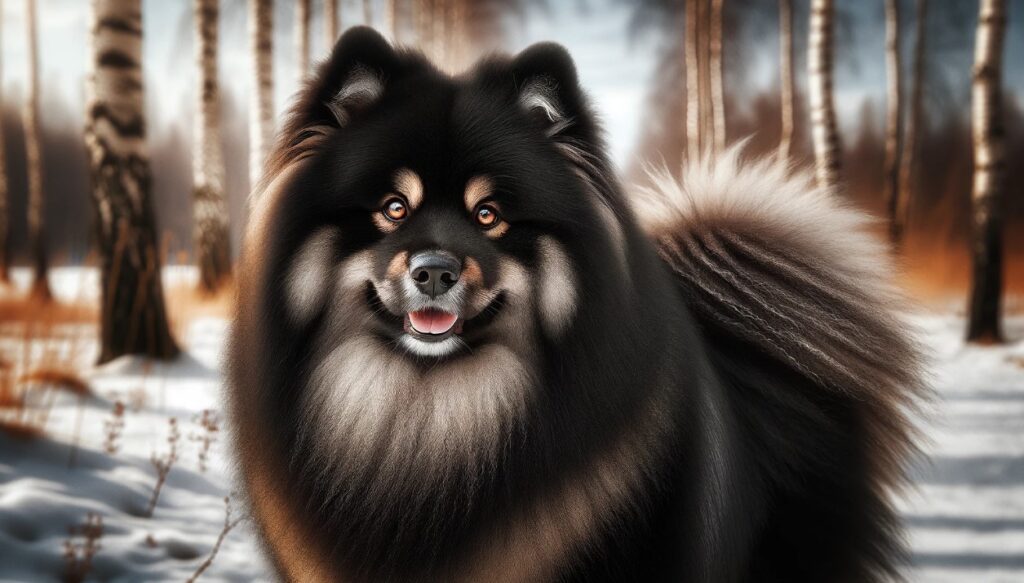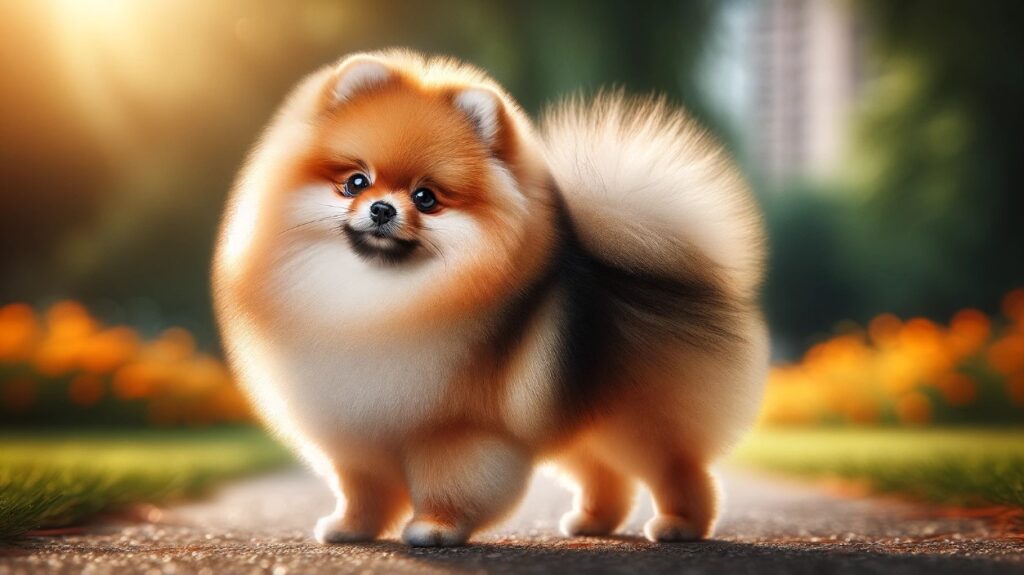The Allure of the Spiraled Tail
Ever watched a curly-tailed dog wagging its tail and wondered why it’s so mesmerizing? Well, you’re not alone. The spiraled tails of certain dog breeds exhibit an allure that is both unique and captivating. As a holistic veterinarian, I’ve often been asked about these adorable spirals by curious pet parents. There is indeed something intrinsically fascinating about the way these tails curl upwards, forming a perfect circle or, sometimes, a tight coil. But beyond aesthetics, there’s a whole genetic science governing these curly tails.

Understanding the Genetics Behind Curly Tails
The curl of a dog’s tail is all down to genetics. A dog’s tail may curl as a result of specific genes that determine the structure and development of the tail muscles and vertebrae. These genes run in breeds, giving us our beloved curly tail dog breeds such as pugs, huskies, and the irresistible Pomeranians. However, the genetics behind this trait can be a complex field of study, with other factors like breed history and evolution playing significant roles.
Historical Significance of Curly Tails
Now, let’s journey back in time. Did you know that the curled tail has significant historical meaning in some cultures? For instance, in ancient Japan, dogs with curled tails were considered to bring good luck, resulting in the popularity of breeds like the Shiba Inu and Akita.
Adaptive Advantages of a Curled Tail
But it’s not all about aesthetics and good luck charms. A curly tail also offers adaptive advantages. Working and herding breeds like the Norwegian Buhund and the Finnish Lapphund sport curly tails, which come handy in harsh climates. The tail can wrap around the face and body, providing warmth and protection from the cold.
The Pomeranian: A Fluffy Favorite
Now let’s meet some of our curly tail celebrities. Take the Pomeranian, for instance, a breed that’s practically synonymous with a cute, fluffy tail curled over its back. Poms are often the first breed that comes to mind when we think of curly tail dog breeds.
The Shiba Inu: An Iconic Japanese Breed
And who could forget the Shiba Inu, the iconic Japanese breed with a thick, curly tail? These spirited dogs often carry their tails in a tight curl over their back, further accentuating their fox-like appearance.
As a dog parent, celebrating the unique characteristics of our curly tail breeds, understanding their temperament, maintaining their health, and learning about their grooming needs can help you build an even stronger bond with your four-legged friend. And remember, every curl tells a tale! Whether you’re a fan of small breeds with curly tails or large ones, there’s a curly tail dog breed out there just waiting to wag its way into your heart.

The Evolution of Curly Tails in Canine Breeds
Have you ever marveled at the captivating corkscrew tail of your canine companion and wondered why it coils the way it does? Well, as a holistic veterinarian, I find the evolution and genetics of curly tail dog breeds to be utterly fascinating. So, let’s take this journey together and delve into the historical significance and adaptive advantages of the spiraled tail in dogs.
Historical Significance of Curly Tails
The story of the curly tail in dogs is an intriguing tale woven into the fabric of canine history. In many ancient dog breeds, a curled tail was seen as a sign of good fortune. For instance, in Japan, dogs like the Shiba Inu and Akita, both sporting beautiful curly tails, served as symbols of protection, health, and happiness. Their enchanting tails were believed to ward off evil spirits.
Apart from cultural significance, the curly tail also played a practical role in some dog breeds. Take the Alaskan Malamute and Siberian Husky, for example, breeds known to endure harsh, frigid temperatures. Their curly tails served as a personal heating system, curled over their noses and faces to provide warmth during extreme cold.
Adaptive Advantages of a Curled Tail
But there’s more to it than just history and symbolism. The curly tail also presented adaptive advantages that have helped certain breeds survive and thrive over centuries. When it comes to expressing emotions and intentions, the tail plays a pivotal role. It’s an essential communication tool in the doggy world. The curl in the tail can amplify these signals, making the dog’s intent clear to other canines.
Additionally, the curly tail can serve to protect the dog’s sensitive rear region from parasites or harmful foliage during their adventures in the wild. In breeds like the Basenji, known as the “barkless dog” from Central Africa, the tightly curled tail was advantageous in the dense forest habitat, helping the dog maneuver through underbrush.
Moving to the world of working dogs, the Norwegian Buhund and Finnish Lapphund, for example, use their curled tails in herding livestock. The distinctive tail, often held high, is easily visible, allowing the dog to be seen over tall grass or in heavy snow, a crucial feature for efficient herding and working with their human partners.
So, my dear dog parent, the next time you see your fur-baby wagging that curly tail, remember that it’s not just a cute feature. It’s a historical, adaptive, and expressive trait that’s deeply rooted in your pet’s genetic makeup. Embrace the spiral, for it’s a special part of your dog’s identity, telling a rich and fascinating story of their breed.
Curly Tail Dog Breeds: Celebrating the Spiraled Splendor
Popular Curly Tail Dog Breeds
When it comes to the universe of curly tail dog breeds, two particular breeds have captured the hearts of canine aficionados worldwide — the Pomeranian and the Shiba Inu.
The Pomeranian: A Fluffy Favorite
Pint-sized yet full of personality, the Pomeranian is one of the most popular among different types of curly tail dogs. Known for their flamboyant double coat and a tail that coils over their back, Pomeranians are charming and lively companions. The breed hails from Poland and Germany and was bred to be a lapdog for nobility.
Not only are Pomeranians known for their luxurious fur and curled tail, but they also have a reputation for being incredibly intelligent and curious. Despite their small size, they have no shortage of energy and require regular exercise to keep them healthy and happy.
From a grooming perspective, the Pomeranian’s thick double coat needs regular brushing to keep it looking its best. Their curly tails are a significant feature and demand careful maintenance to prevent matting and tangles.
The Shiba Inu: An Iconic Japanese Breed
Hailing from the Land of the Rising Sun, the Shiba Inu is a dog breed with a curly tail that’s impossible to overlook. This breed is compact, agile, and blessed with a tightly curled tail that is nothing short of being iconic.
Shiba Inus are known for their independence and can be a bit aloof at times, but they also have a playful and affectionate side. They were originally bred for hunting and are known for their spirited nature and bold attitude.
Their dense double coat is similar to that of a Pomeranian, but unlike the Pomeranian, their fur is short and straight. Their curly tails, however, require the same attention to avoid any potential skin issues or matting. Loyal, bold, and full of charm, the Shiba Inu is a captivating representative of curly tail dog breeds.
From the spirited and fluffy Pomeranian to the dignified and independent Shiba Inu, curly tail dog breeds bring a unique blend of charm, character, and physical appeal. Whether you’re a fan of small breeds or you’re looking for a larger companion, these breeds offer something for everyone. Here’s to celebrating the spiraled splendor of our curly-tailed companions!
Working and Herding Dogs with Curly Tails
Among the multitude of curly tail dog breeds, there are a handful of working and herding dogs that feature this distinctive tail. The twirled tails aren’t merely for aesthetics; they often serve crucial functions in these dogs’ working lives.
The Norwegian Buhund: A Spirited Herder
Firstly, we have the Norwegian Buhund, a breed whose name translates to “farm dog.” The Buhund’s curly tail is not just a striking feature but also an essential tool for herding and guarding livestock.
These dogs carry their tails curled tightly over their backs, adding to their compact and sturdy appearance. The Buhunds are known for their high-energy, intelligence, and tenacity, essential traits for a competent working dog. Their curly tails often serve as a signal, conveying their alertness and readiness to spring into action, a crucial detail in the herding world.
The Finnish Lapphund: A Reindeer Herder’s Companion
Next on the list is the Finnish Lapphund, a breed from the spitz family, native to Finland. These dogs were initially bred to herd reindeer, a job requiring resilience, agility, and intelligence.
The Lapphund’s curly tail is a staple feature of the breed. It’s carried over the back and to one side, creating an arch. This distinctive tail positioning is a helpful tool in harsh weather conditions as it aids in shielding the dog’s face from snow. Additionally, the curl of their tail can signal their mood and intent to other dogs and their human companions, which proves invaluable in their herding tasks.
While the Lapphunds are no longer primarily used for reindeer herding today, their unique blend of intelligence, patience, and adaptability has made them popular in various dog sports and as family pets.
In closing, the Norwegian Buhund and the Finnish Lapphund are both splendid examples of curly tail dog breeds that have utilized their distinctive tails for their traditional occupations. Whether acting as a signal or as a shield against harsh weather, these curly tails are far more than just a pretty feature. They are a testament to the fascinating interplay of genetics, adaptation, and occupation in the world of dog breeds.

Small Breeds with Curly Tails
Let’s dive into the world of small curly tail dog breeds. These compact companions are known for their adorable spiraled tails, adding an extra touch of charm to their overall appearance.
– Pomeranian: These fluffy favorites are known for their luxurious double coat and their tightly curled tail that rests on their back. They’re energetic, intelligent, and make great companion dogs.
– Shih Tzu: Shih Tzus are small dogs with a big personality. Their tail is plumed and curls over their back, adding to their regal appearance. They’re known for their friendly and outgoing nature.
– French Bulldog: French Bulldogs, or “Frenchies,” are small dogs with a sturdy build. Their tail is naturally short and can either be straight or corkscrew-shaped.
– Pug: Pugs are small dogs with wrinkled faces and curly tails. Their tail curls tightly over their hip, and some Pugs even have a double curl!
Large Breeds with Spiraled Tails
Now, let’s turn our attention to some of the larger dog breeds that sport the stylish curly tail.
– Akita: Akitas are large, powerful dogs with a thick double coat. Their tail is large and curls over their back, giving them a noble appearance. They’re known for their loyalty and protective nature.
– Siberian Husky: Siberian Huskies are medium to large dogs known for their striking blue or multicolored eyes and their bushy tail that curls over their back. They’re energetic, intelligent, and have a strong prey drive.
– Alaskan Malamute: Alaskan Malamutes are large, strong dogs bred for their ability to haul heavy freight as a sled dog. Their tail is plumed and curls over their back, giving them a wolf-like appearance.
– Samoyed: Samoyeds are large dogs known for their friendly and adaptable nature. Their tail is one of their most distinctive features. It’s long, heavily coated, and curls up and over their back.
Remember, regardless of the size or breed of your curly tail dog, each one is unique and brings its own special charm. Whether you’re a fan of small breeds with curly tails or prefer larger breeds with spiraled tails, there’s a curly tail dog breed out there that’s perfect for you.
Unique Characteristics of Curly Tail Breeds
Temperament Traits in Curly Tailed Dogs
When it comes to curly tail dog breeds, their personalities are as varied as their tails’ spirals. However, some traits are notably common among them.
For example, many curly-tailed dogs, like the Norwegian Buhund and the Finnish Lapphund, were bred for work. These breeds retain a strong work ethic, making them energetic, intelligent, and highly trainable. They’re also known for their loyalty and protective nature, so they can make excellent family pets.
On the other end of the spectrum, some curly tail dog breeds like the Pomeranian and Shiba Inu are known for their spunky, independent spirits. These dogs have a lot of personalities packed into their small bodies. They are alert, curious, and often a bit mischievous.
Regardless of their breed, it’s important to remember that each curly-tailed dog is unique. Their temperaments will be influenced by their genetics, upbringing, and individual experiences.
Health Considerations Specific to Curly Tails
Just as their personalities are distinct, the health concerns of curly tail dog breeds are also unique. The very trait that gives these dogs their adorable tails can also lead to certain health issues.
Curly tails are the result of the vertebrae in the tail being shaped or arranged differently. While this usually doesn’t cause any problems, in some cases it can lead to spinal issues. For example, certain breeds like the French Bulldog and the Pug are prone to a condition called hemivertebrae, where the vertebrae are misshapen.
This can lead to a range of symptoms, from no apparent issues at all to serious neurological problems like difficulty walking or incontinence. As such, it’s important for owners of curly tail dog breeds to be aware of these potential health risks and to consult with their veterinarian if they notice any unusual symptoms in their dog.
Another health consideration for curly tail dog breeds is their propensity to develop skin issues around their tails. The tight curl of the tail can trap moisture and dirt, which can lead to infections if not properly cleaned and dried. Regular grooming and attention to the tail area can help prevent these issues.
However, remember that not all curly tail dog breeds will encounter these health problems. Their likelihood depends on a variety of factors, including the breed and the individual dog’s genetics.
Understanding these unique temperament traits and potential health concerns can help you provide the best care for your curly-tailed companion, ensuring they stay happy, healthy, and their spiraled tails keep wagging!

Grooming and Care for Curly Tail Dog Breeds
Caring for a curly tail dog breed can be a unique experience. It’s not just about their playful nature or expressive personality; their distinctive spiral tail requires special attention too. Let’s delve into the best practices for maintaining a healthy tail, and discover some grooming tools and techniques suited for our curly-tailed friends.
Best Practices for Maintaining a Healthy Tail
While a dog’s curly tail may be enchanting, it’s essential to consider that the tail’s health is a crucial part of the dog’s overall wellbeing. Here are some tips to help maintain your dog’s tail in the best condition:
- Regularly check for signs of infection: Look out for redness, swelling, or discharge around the tail base, which may indicate an infection. Any sudden changes in tail carriage, such as a usually curly tail hanging straight, should also raise concern.
- Avoid pulling or tugging on the tail: This can cause discomfort and potential damage to the tail’s structure. Always handle your dog’s tail gently, whether during play or grooming.
- Protect from frostbite and sunburn: Dogs with short hair and less fatty tissue, like the Shiba Inu, are susceptible to extreme temperatures. In hot weather, apply a vet-approved sunscreen on the tail, and during winter, limit your pet’s exposure to cold.
Grooming Tools and Techniques for Curly Tails
Proper grooming is key to keeping a curly tail dog’s tail healthy. Specific tools and techniques can make grooming more effective and less stressful for both you and your dog.
- Use a suitable brush: Depending on your dog’s coat type, different brushes are suitable. For example, a slicker brush works well for the thick, double-coated Pomeranian, while a bristle brush is perfect for short-haired breeds like the Shiba Inu.
- Perform regular brushing: Brush your dog’s tail regularly to prevent mats and tangles, especially in breeds with long hair. Brushing also stimulates blood circulation, promoting healthier skin and hair.
- Apply a detangler: If your dog’s tail has long hair and is prone to matting, applying a dog-friendly detangler before brushing can help ease out knots without causing discomfort.
- Trim the hair if necessary: For breeds like the Norwegian Buhund and Finnish Lapphund that have bushy tails, occasional trimming can help keep the tail neat and clean, and prevent any poop from getting stuck to the tail hair.
Remember, grooming your curly tail dog breed should be a bonding experience. Always approach grooming with patience and positivity, rewarding your pet for good behavior. This ensures your dog feels comfortable and associates grooming with happy times!
Ethical Breeding Practices for Curly Tail Dogs
If you’re passionate about curly tail dog breeds, you’ll likely be interested in learning about the responsible breeding practices that are so crucial for these adorable canines. Ethical breeding is about more than promoting those distinctive, spiraled tails – it’s about safeguarding the health, temperament, and longevity of the breeds we love so much.
First off, every reputable breeder will prioritize health screening. This involves genetic testing to identify potential hereditary health issues that are more prevalent in certain breeds. By understanding a dog’s genetic profile, breeders can make informed decisions about breeding to avoid passing on these conditions.
Another key aspect of ethical breeding is ensuring a diverse gene pool. This helps prevent inbreeding, which can lead to a host of health problems and the amplification of negative traits. It’s important for breeders to be knowledgeable about their breed’s gene pool and to consider it when choosing breeding pairs.
Lastly, ethical breeders never prioritize aesthetics over health. While the curly tail is a charming characteristic of these breeds, it should never be the sole focus of a breeding program. The overall health and well-being of the dog must always take precedence.
Conservation Efforts for Rare Curly Tail Breeds
Preserving the diversity and vitality of curly tail dog breeds also involves conserving rare and lesser-known breeds. Conservation efforts are as much about celebrating the rich tapestry of canine breeds as they are about protecting these wonderful dogs from the risk of extinction.
One such breed facing this risk is the Norwegian Lundehund, a breed known for its unique physical characteristics, including its curly tail. To help preserve this breed, the Norwegian Lundehund Association of America, Inc. (NLAA) has implemented a strict breeding program. This program focuses on increasing genetic diversity, improving health, and promoting the breed.
In the case of the Basenji, an African breed with a tightly coiled tail, associations like the Basenji Club of America have created breed preservation programs. They encourage responsible breeding and assist in finding loving homes for these unique dogs.
The journey to maintain the diversity, health, and distinctive traits of curly tail dog breeds is a cause that all dog lovers can take to heart. Ethical breeding practices play a critical role in this endeavor, as do preservation efforts aimed at safeguarding rare breeds with those delightful spiraled tails. As we celebrate the variety and beauty of these breeds, let’s also commit to ensuring their future – one curly tail at a time. It’s a celebration of more than just a charming physical trait; it’s a celebration of the breeds themselves and the joy they bring into our lives.
Frequently Asked Questions
Q1: What are some examples of curly tail dog breeds?
A: Some examples of curly tail dog breeds include the Pug, Shiba Inu, Alaskan Malamute, and the Akita.
Q2: Does a curly tail indicate any specific breed traits?
A: While a curly tail can be a distinctive feature of certain breeds, it doesn’t necessarily indicate any specific breed traits. It’s more of a physical characteristic than a behavioral one.
Q3: Can a dog’s tail change from straight to curly as they grow?
A: Generally, a dog’s tail will not change from straight to curly as they grow. The shape of a dog’s tail is determined by its genetics and will typically remain the same throughout its life.
Q4: Are there any health issues associated with curly tail dog breeds?
A: Some curly tail dog breeds can be prone to certain health issues, but these are typically related to the breed itself rather than the tail. For example, Pugs can be prone to breathing difficulties due to their short snouts, but this is not related to their curly tails.
Q5: How should I care for my curly tail dog’s tail?
A: In general, a curly tail doesn’t require any special care. However, it’s always a good idea to check your dog’s tail regularly for any signs of injury or infection, just as you would with any other part of their body.
Dr. Candy, a holistic veterinarian and certified raw dog food nutrition specialist, graduated from Oklahoma State University in 2009 with a DVM and has since specialized in companion animal nutrition, advocating for species-specific diets. With a background in wildlife rehabilitation and oil spill response, she combines holistic health and conventional medicine in her unique approach to treating chronic diseases, allergies, and autoimmune conditions in pets. As the owner of a veterinary practice in Colorado and an author, Dr. Candy is dedicated to educating pet parents and improving the health and happiness of animals.




